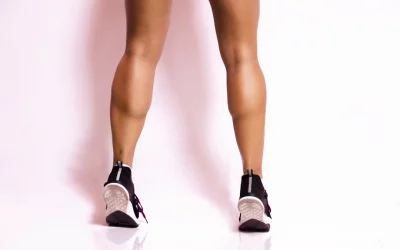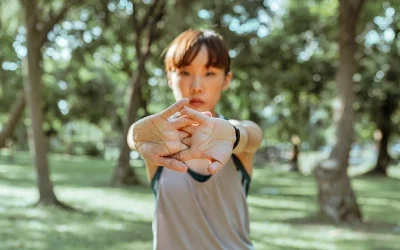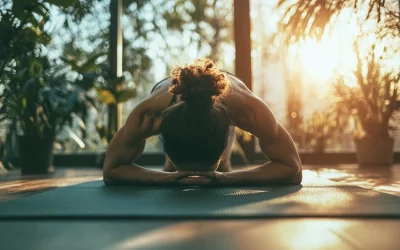When you think of strengthening your core, you may think of hours spent at the gym. In reality, the best way to begin building core muscle strength is to start doing manageable exercises at home. The beauty of these poses is that you can stretch your core muscles in the process of strengthening them.
What are your core muscles?
“The core consists of the muscles surrounding your trunk, including your abdominals, obliques, diaphragm, pelvic floor, trunk extensors, and hip flexors.” – Healthline.
Why should I strengthen my core?
With a stronger core, you’ll be able to improve your posture and provide more support for your spine. Picking items off the floor and getting back up will become easier. You may also notice improved bladder control and an easier time breathing!
Like any muscle, you can strengthen your core muscles by actively using them more than in daily life. When you push your muscles even slightly beyond normal use, you create microtears. This is why you’ll feel sore for a few days after intense exercise, but as your body heals, it repairs those microtears and strengthens the muscle.
Strengthening your core with stretching.
These are a handful of stretches that can help you to strengthen your core while increasing your overall range of motion. If you would prefer a less-thinking, more-guided approach, try the strengthening routines available on WeStretch. These strengthening routines encourage functional movement on a level that is suited to every fitness level!
Standing poses
These are great beginner core exercises if you’re just starting out. Be sure to have a table or something sturdy to use for balance if you need it.
Stand with your arms comfortably extended above your head until you feel a stretch. Engage your core to keep your posture straight.
Lift your leg in all directions, while balancing on the other one. This will enhance your balance and your core strength, while stretching out your hip, leg, and lower back muscles.
Tilt and rotate your torso. You will feel your stomach and back muscles engage to keep you upright as you tilt to the right and left.
Cat pose
Start on your hands and knees, with your hands placed directly under your shoulders and your knees directly under your hips. Keep your head and neck in a comfortable, neutral position.
From here, lift one arm off the ground so that it is parallel with your ear. This provides a great stretch for your shoulder and rotator cuff, while engaging your core to keep you stabilized.
Opposite to the arm exercises mentioned above, lift one leg straight up off the ground at a time. For variations, try sliding it behind your body, out to the side, or bend it towards your chest.
Touch your toes
Bending down to touch your toes (or as far as you can) and slowly coming back up without falling over is a great goal to achieve.
If you’re looking for additional motions, try raising one of your legs behind you to be parallel with your torso. Try clasping your hands behind your back and allowing them to fall forward, using gravity to enhance the motion.
Lunges
Both forward-facing lunges and side lunges are great for building strong core muscles by engaging them to maintain your balance.
While in a lunge position, tilt and rotate your torso to stretch different muscles, as well as lean forward and back. These are great foundational stretches, but when you’re starting off, don’t hesitate to hold onto something to prevent falling over.
Planks
While planks and bridges are known for their full body and core strengthening, they can also offer some great stretches.
Try lifting your hands or legs off the ground (one at a time), moving your hands further apart or closer together, or even stretching your neck in different positions.
Keep in mind, though, that if sustaining a full plank is too hard on your body, doing a plank from your knees can be just as effective!
Fun activities that also engage your core!
While you will see the most results with targeted core exercise and stretching, here are a few other activities that can also work on your core muscles.
Laughter.
Do you remember the last time you laughed so hard at a joke or a movie and your stomach hurt after? The soreness you feel after laughing is from the micro tears from your core muscles working hard.
This means, by laughing more often, not only will you improve the quality of your life, but you might even get a six-pack out of it! 😉
Singing.
Singing, especially classical or choral singing, involves a lot of breath and muscle control. By singing regularly, you can strengthen your diaphragm and your surrounding muscles.
Fear.
While this may not be seen as a “fun” activity, when you are scared, your muscles tense up. If you are scared often enough or for long enough, such as watching an intense horror film, this fear can improve your core strength. That being said, if your fear is stemming from sources out of your control, then it might be best to talk to someone to address your concerns.
Tips on gaining core strength.
- You will not develop a six-pack of abs overnight. However, you can start making small efforts today that will have big results later.
- Instead of doing longer sessions, incorporate more regular and frequent small sessions. It is easier on your body and you’ll be more likely to create the habit.
- Find a methodology and stick with it. While variety in your exercise is nice, switching every time won’t guarantee you results. A little while ago, Tik Tok had a stomach dance challenge, and this worked for many people because it allowed them to make a small, consistent effort, and they were rewarded with positive results because of it.
Any links included are for reference, additional information, or entertainment value only, without monetary compensation. Contact us on social media or at [email protected]. Photos courtesy of Unsplash.
This article is not intended to act as or replace medical advice. Please talk to your healthcare practitioner if you have any concerns.
Written by Kayla Willsey
Updated November 19, 2021






